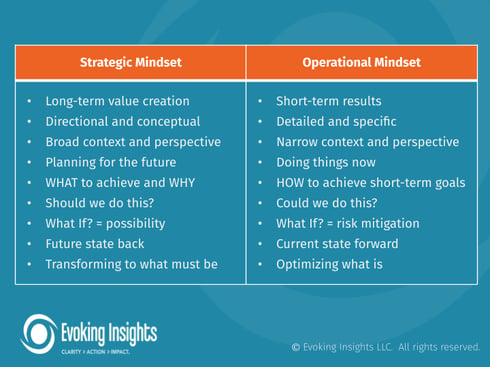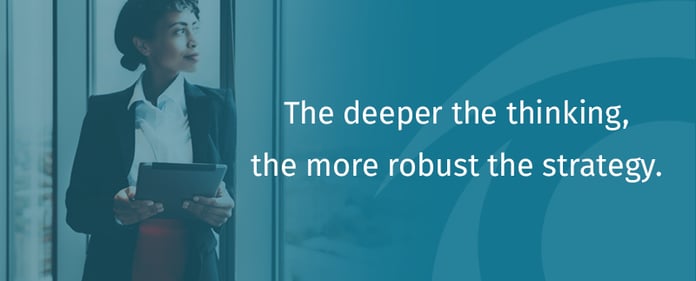What does it take to be a strategic leader?
Strategic leadership isn't easy. Statistics show that fewer than 10% of leaders exhibit key strategic skills, behaviors and mindsets. Faced with tremendous pressure to make short‑term numbers and show immediate wins, it can be hard to lead strategically. As many an executive has said to me, "We're running fast in many different directions."
Do you feel like you are thinking, acting, and influencing your organization in a strategic way?
The Center for Creative Leadership defines the three high‑level competencies of strategic leaders as:
- Strategic Thinking - understanding the complex relationship between your organization and its environment.
- Strategic Acting - taking decisive action consistent with the strategic direction of your organization — despite ambiguity, complexity, and chaos.
- Strategic Influencing - building commitment to the organization’s strategic direction.
These three competencies are consistent with my own experience as a leader and strategist. I help leaders cultivate and practice these three competencies by breaking them down into tangible skills and experiences.
Because it’s not enough to tell someone to “be more strategic.”
Strategic Thinking
Strategic thinking is critical to leading strategically. It is time spent to gain strategic clarity and insight. Yet good strategic thinking can be rather intangible.
The good news about strategic thinking is that it can happen at any time, and at any level of an organization. You can do it by yourself or with a team, and you can apply it to your day‑to‑day actions.
Where do you start?
With a specific mindset and behaviors. What mindset are you bringing to your decisions? A strategic mindset involves both breadth and depth of perspective. It allows you to see the business and decisions through the perspective of positioning your business (or function) for the future.

Anticipate, challenge and interpret are three strategic behaviors you can apply to your next strategic decision.
Strategic thinkers are identifying connections, patterns, and key issues or opportunities. They do this all with the purpose of creating competitive advantage and positioning the organization for an envisioned future.
Instead of creating a list of initiatives, they are asking: What is our theory of competitive advantage?
Flex Your Strategic Thinking Muscles
Here’s just one example of an exercise I share to boost strategic thinking. Choose a verb from the following list:
-
- Scan
- Discern
- Interpret
- Challenge
- Envision
- Ideate
- Frame
-
- Market trends and patterns
- Industry and competitive dynamics
- Customers’ needs and consumption patterns
- Potential disruptions
You will learn to master strategic thinking through experimentation and practice. It starts with taking time to think strategically, creating fertile ground for insights.
The deeper the thinking, the more robust the strategy.

Strategic Acting
Strategic leadership includes translating that next‑level strategic thinking and mindset into your day‑to‑day actions.
Strategic acting is aligning short‑term actions with long‑term direction through your day‑to‑day decisions – actively managing the tension between daily tasks, quarterly results, and success in the long‑term. The trick is staying future‑focused while taking action in the moment. And having the courage to take short‑term hits for long‑term gain.
Like Starbucks CEO Howard Shultz. His strategic actions “came under tremendous criticism” for closing every Starbucks for a day‑long re‑training. He had the courage to stick to his bold plan, taking a risk, and facing criticism. That is true strategic leadership in action.
Realized strategy lies in the tough decisions made – despite all the ambiguity, complexity, uncertainty (and criticism). The consistency of action on those decisions will be determined in the day‑to‑day. The quality of those strategic decisions will be revealed over time.
Be Willing to Be Wrong
And strategic acting is learning and adapting to a future that is different from what we expect — or even imagine.
A robust strategy is based on a potential future that could unfold. But what if that future does not occur? What if a global pandemic upends everything you knew about your business?
When you are acting strategically, you are approaching all of this with humility, curiosity, and resilience. Continually scanning for changes, opportunities, and even missteps. You are a steward of transformation, and that means accepting the unknowable shifts and adapting as you go.
Strategic Influencing
Let’s assume you feel confident as a strategic thinker and your day‑to‑day actions are aligned with your strategy. Your strategic leadership challenge is that you need to bring others along for the ride.
Because where there is strategy, there is change. And where there is change, there is resistance to that change.
Challenges of Strategic Influencing
Influencing strategically is high stakes. It involves influencing the most senior leaders of an organization (and/or Board of Directors) to support your strategic decisions and direction. Now you are out on a limb, standing for an unknowable future in front of senior leaders. The uncertainty and ambiguity of strategy can be quite uncomfortable.
And once you have clarity of strategic direction, it involves continual influence across the organization to deliver the strategic transformation envisioned.
Learning to “Speak” Strategy
Many leaders that I work with effectively drive change down into their organizations once a decision has been made. But influencing strategic decisions before they are made is new territory. As a strategy coach, I help leaders hone their strategic story to more effectively make their case with executives. They learned to get clear on their vision, context, and objectives to deliver the “change agenda.” Once they could “speak strategy,” they were better able to amplify their influence.
Cultivate a Trusting Mindset
And the challenge of influencing senior executives can leave even the most confident person feeling insecure. Most of us experience self‑doubt, uncertainty, and pressure because the stakes are so high.
It can help to approach your next meeting with a mindset of trust. Harnessing your creative and resourceful side allows you to effectively lead through the discomfort of complexity and uncertainty.
A great place to start strengthening your strategic influencing is to reflect and capture your current influencing strengths. Then discover how you can leverage those strengths for strategic influencing. Is your greatest opportunity in:
- Taking a stand for an unknowable future?
- Effectively influencing senior executives?
- Navigating change resistance?
Practice Being a Strategic Thinker, Actor, and Influencer
As you go about your day‑to‑day activities, pay attention to the ways you think, act, and influence others.
You may make some important discoveries.
Notice what others around you are doing. Do you notice yourself or other people applying the strategic competencies?
Sometimes, bringing a simple awareness of how we are in the world can bring insights and radical change.
Like everything good and important, it takes practice.



